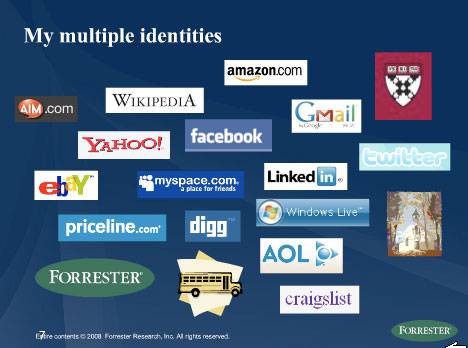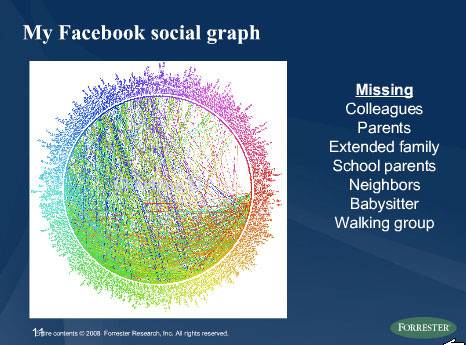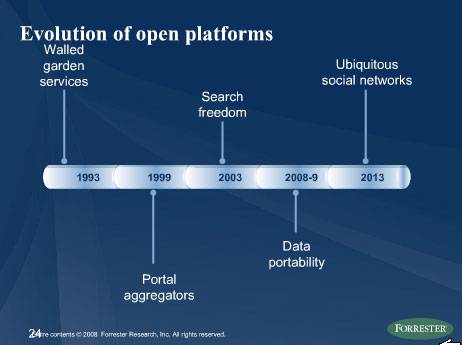Charlene Li gave the opening keynote at today’s Graphing Social Patterns conference. The keynote was titled “The Future of Social Networks” and Charlene clarified that specifically she was focused on five to ten years out in her presentation. Her basic thesis is that in the future, ‘social networks will be like air.’ In other words, it will be ubiquitous as you navigate across the web and sites will feel inadequate (like you can’t breathe) if a user’s social network isn’t part of the experience.

The majority of Charlene’s talk then focused on how each component of a social network will evolve given this vision:
- Profiles
- Relationships
- Activities
- Business Models
Profiles: A Universal Identity
Like most of us, Charlene has literally dozens of identities online (see slide below).

Moving forward she’d like to see a universal identity. Her specific proposal centers on either email and/or mobile phones, since this would be an identity she controls. Thankfully, Charlene also anticipates a federated approach (such as OpenID.) Also, she anticipates a few major players will probably serve as major federation focus points. We have already seen this happen begin to happen with both AOL and Yahoo! supporting OpenID.
Charlene also talked about the “Bill of Rights for Users of the Social Web,” a document created by a number of thought leaders in the social web: Joseph Smarr, Marc Canter, Robert Scoble & Michael Arrington. The document states:
We publicly assert that all users of the social web are entitled to certain fundamental rights, specifically:
- Ownership of their own personal information, including:
- Control of whether and how such personal information is shared with others; and
- Freedom to grant persistent access to their personal information to trusted external sites.
- their own profile data
- the list of people they are connected to
- the activity stream of content they create;
I imagine there will be more conversation on this in the afternoon panel Dan Farber is moderating on Data Portability.
Relationships: A Single Social Graph
Over the next few years, Charlene pointed out that a unified social graph will develop. She showed her current social graph as it exists inside Facebook, and then pointed out what it was missing: colleagues, parents, extended family, school parents, neighbors (see slide below). I think this is something we all realize intuitively – so the overriding point is that our real social graph is far more complex.

New ‘Entrants’ Will Be Portals
I actually found this one of the more interesting points from Charlene’s presentation. She proposed that the a number of ‘new entrants’ will emerge, except that they won’t be startups at all. Instead, she predicts that a number of the major portals (Google, Microsoft Live, Yahoo!, and AOL) will actually fill the the relationship mapping gap. She pointed to 4 reasons why they are natural entrants:
- Millions of Regular Users
- Search & Deep Content
- Ad & Content Networks
- Relationship Maps
Activities: Social Context for Activities
Going back to ‘social networks being like air’, not surprisingly Charlene projects that social context will be important for most online activities. As an example of how this might happen, she used shopping. She talked about Amazon integrating with Facebook (or any other repository of social graph info) such that they could highlight book reviews from her friends. Charlene also pointed out that any portal could easily incorporate social data into their site. She used Yahoo! as an example saying they could:
- Search based on what my friends find relevant
- Elevate stories tagged by my friends — anywhere (maybe multiple social graphs web 2.0 & shopping)
- Compare daily portfolio performance to friends
- In terms of advertising, which of my friends owns a Focus & what do they think of it?
Business Models: Social Influence Defines Marketing Value
When talking about business models, her basic point was that we have yet to properly value networks based on their social value. She pointed to Marian Salzman’s (of JWT) concept of personal CPMs. The basic idea being that an individual’s authority on specific topics plus their network’s interest and authority on the topic, results in a value of reaching that user. If this is true then “social networks will have to compete to have the best experience for high influence people.”
Conclusion
Based on the vision she laid out, Charlene ended with a map of how open she anticipated these open platforms evolving.

To realize this vision of ubiquitous social networks, Charlene pointed out 2 things that must happen:
- We need the technology to evolve, which she wasn’t that worried about
- We need to increase trust, which she challenged the industry to think about
You can view all of Charlene’s Slides here.
| View | Upload your own











